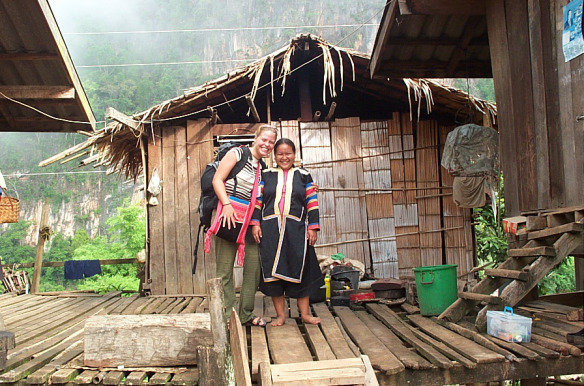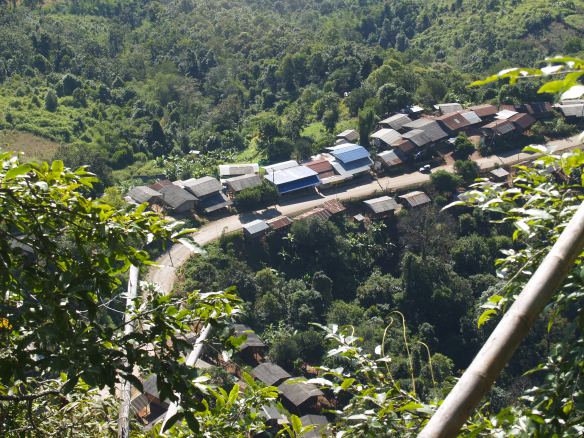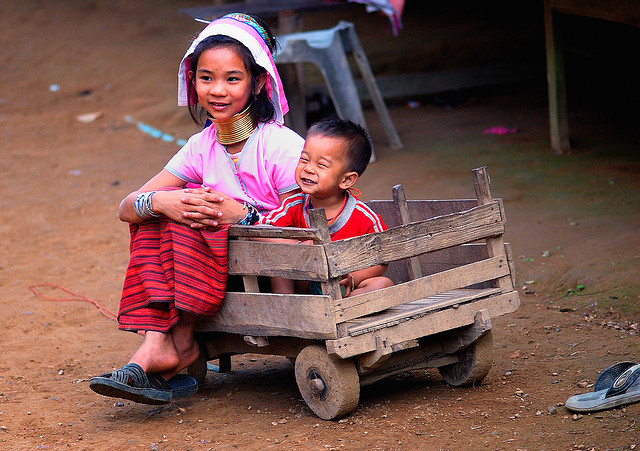Staying with hilltribes in Thailand

Villages all over the world are starting to open their doors to tourists. Polly Pattullo meets the hilltribes of northern Thailand
We were sitting on the floor of a house in Ja Bor in north west Thailand, a three-hour drive from Chang Mai on a road of endless hairpin bends, talking to village women about their traditional black coats. A supper of wild eggplant, pumpkin, pork, chilli paste, rice, omelette and sweet tea had been cleared away and these mountain people of the Lahu tribal group were explaining about the coloured stripes on their coat sleeves. The colours, they said, were based on what we had eaten: red for the sharp-faced pigs which rootled around underneath stilted wooden homes; yellow for tea; white for rice and blue for vegetables. The women asked if I would like to try on one of these home-crafted, open-fronted garments, edged in white with elegant slits up the side. The coat felt cosy in the cool night air but it must be stifling during the heat of the day. "Yes, its hot," they said. "We wear our black trousers all the time but not the coat."
Earlier in the day, we had gone on a hike along dusty paths and among craggy mountains, escorted by villagers (the women in their coats) and a small boy in an orange T-shirt. Here, tucked into valley basins are fields of rice, maize, vegetables and a flourishing pig farm – further connections with those coats of many colours. Stopping to take in the quilted shapes of the rice fields, swaying bamboos and deciduous forests, we sat on a rough wooden bench. We learn it was made by a villager as a small penalty for not producing enough crops for the community.
A more ancient resting place is revealed in a hidden cave. It's a dizzying climb up a wooden ladder built into a cliff to see a bunch of coffins placed in limestone orifices. The mysterious remnants of an unknown people, these boat-like wooden coffins resting on stilts date back some 1,500 years. Limestone coffin caves are a feature of tourism in this part of Thailand but this one, high above ground rather than below it, is most unusual.
The Lahus, like the Karen and other hill tribes of northern Thailand, are newcomers to tourism to the demands of inviting strangers not only to poke around their environment but also to stay in their homes. They are vulnerable to the sort of tourism that objectifies and exploits them. But the villagers of Ja Bor are developing a tourism that they control and manage and profit from.
Our local guide, Ja Yor, dressed in a loose, black satiny jacket and the sort of low, crotch-slung trousers that British teenagers would die for, said that "tourists can see our agriculture, and this is a way of reminding our young people that we have a good life here." Tourism has also inspired him to research his own culture: it has made him confident, and has given the village a new pride in their identity.
Some hundred miles to the south, in the villages of Mae Klang Luang and Pha Mon, a similar process is taking place. These two Karen villages lie inside the Doi Inthanon national park. Once this area suffered from excessive opium poppy growing and deforestation while the tourists who came never spent any money in the villages. But, as in Ja Bor, community-based tourism has brought hope not hindrance. Somsak Khiriphumtong, the inspirational co-ordinator from Mae Klang Luang, believes that tourism can help sustain the forests as well as bring income to the village as they wont have to resort to felling trees for sale.
Visitors to Mae Klang Luang stay in a local home mattresses on the floor with outside washing facilities or in a large dormitory-style building, and are fed lavish amounts of food from the villages ubiquitous rice fields, its fish farm, organic vegetable garden and from the nearby forest, nurtured by sparkling streams. Close to a waterfall is a delicate bamboo shrine to thank the spirits for carrying water to the rice fields. And then there is coffee production. Dried by the sun, roasted over an open fire and sifted on bamboo platters, this arabica coffee bears a Fairtrade label and gets sold to Starbucks.
Of the 64 houses in the village, three-quarters now have some stake in tourism. Somsak said that he had to tell the community that "you have to wait for fruit to grow before you harvest it and tourism is like that. Now they are much happier. We sell our local way of life but we don't lose anything." Indeed, this innovative man has opened a small museum to conserve old village tools and household equipment, such as terracotta pots, and bamboo mugs now replaced by plastic.
This is a remote world despite mobile phones and electricity where outsiders can gain a taste of life in unknown rural Thailand which is about as close to an "authentic experience" of someone else's culture as is possible for anyone who is not Thai. There is still a sense that the encounter between host and guest is fresh and intriguing. The challenge will be maintaining it.
Many of these villagers have seen what happens when tourism occurs without proper planning and consultation. Surasith Donjaiphaiwan, a young man with spiky hair and a big grin, used to work as a guide. "Tour operators weren't friendly," he said. "The tourists were drunk, asked for drugs and had no respect." He has returned to his nearby village, Pha Mon, to help develop tourism, and the "Bamboo Pink House" is one result. Built by the community, the lipstick-coloured wooden building sits above a sweep of rice fields and provides accommodation for six people, visitors who find enjoyment trekking in the forests where every leaf seems to have a purpose, for food, religion or health or exploring the pattern of village life.
This has not happened by accident. A Thai NGO called the Community-Based Tourism Institute (CBTI) has spent many years working in villages such as Ja Bor, Mae Klang Luang and Pha Mon. Forty Thai villages from the far north to mangrove fishing villages in the south have been involved. "We want tourism to contribute positively for people and the environment," said Peter Richards of CBTI. "We see tourism as a tool for development. But we need to allow space for the small players in tourism to grow."
Richards is CBTI's co-ordinator of a radical initiative that recently brought together villagers from nine Thai communities along with the same number of Thai and UK tour operators, all carefully chosen for their sensitive tourism practices. It was a pioneering exploration of how these three strands could work together to attract "responsible" tourists to rural Thailand.
CBTI's work is an important counterpoint to Thailand's voracious tourism development dating from the Vietnam war when GIs went there for RR which has eaten into communities with no thought of sustainability. Those, such as the hill-tribes with their distinctive traditions, are most likely to be its victims. And perhaps its most abusive form is found close to the Burmese border an hours drive from Ja Bor. There, Burmese refugees have long languished inside camps. Outside, women of the Kayan tribal group, also refugees from Burma but of economic value to the tourist industry, are on parade: for the many brass collars they wear around their neck from childhood give the impression of unusual elongation. So they pose for photographs and sell dismal souvenirs that they do not make (apart from some woven cloth) and receive a pitiful wage while others benefit from the money (about 5) that each tourist has to pay to visit them.
The opposite of that unequal relationship is what community-based tourism is all about with guests and hosts gaining mutual benefits. But making it all work is difficult. The community leaders are anxious for the tour operators to send the right sort of tourists. The tour operators will do their best explaining to their clients what to expect but as CBTI's Peter Richards explains, "Tour operators can't choose their clients they can't make them fill in a three-page application form."
And what do the tour operators want from the communities? Don't change yourselves for us was the message. "Our guests are looking to discover your way of life, not a prefab addition or one that you think they might want. "They don't want just to observe your life, they want to live your life for a day."
And that is what the communities have learned that their culture is important. As one community member from Koh Yao Noi, an island in the south of Thailand, said: "The sea is normal to us but interesting to tourists. Taking visitors fishing makes us see things differently. Our tourism is not what you get from a hotel, but our service is from the heart."
How to pick a community tourism holiday
Community-based tourism is rural tourism managed and operated by local community groups, so income from holidaymakers benefits them directly, reinforces a sense of cultural identity and provides opportunities for sustainable development.
There are no equivalent to a Fairtrade mark for the travel industry, so use this checklist.
· Check the website for prominence of some kind of mission statement about their ideas on ethical/responsible tourism.
· Ask your tour operator whether they include community-based tourism in their itineraries and how the communities you plan to visit specifically benefit from tourism. Communities should be fairly paid (not easy to assess) and should be pocketing all of the profits from their input, such as homestays, unless they are in partnership with a local entrepreneur such as a lodge-owner, when profits will be shared.
· If you choose to take a community-based tour, ask the tour operator if it will be possible to visit village projects funded by tourism - it might be equipping a school, repairing a health clinic, reforestation, an organic vegetable farm, or even a waste disposal system - but it's fun and interesting to see where some of your money is going.
· Stay clear of holidays which emphasise "ecotourism" - this has become a debased word. Instead, focus on operators who have a social responsibility emphasis.
· Tour operators who include community-based tourism in their brochures should have the communities at heart. Once you get there, signs to look out for that all is not well might be the presence of too many other tourists (community-based tourism is about quality not quantity); and outsiders interpreting local life and culture rather than the villagers themselves, even if this is through an interpreter.
· Find out as much as you can about the community before you book so that you know what to expect in terms of conditions, culture and lifestyle.
· When you're there, make ethical choices like buying local beer and local handicrafts from independent suppliers.
By Polly Pattullo
03 may 2008
www.theguardian.com


